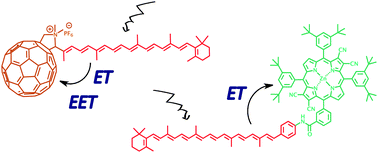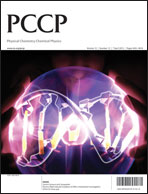Photophysical investigations of molecular donor–acceptor systems have helped elucidate many details of natural photosynthesis and revealed design principles for artificial photosynthetic systems. To obtain insights into the factors that govern the partition between excited-state energy transfer (EET) and electron transfer (ET) processes among carotenoids and tetrapyrroles and fullerenes, we have designed artificial photosynthetic dyads that are thermodynamically poised to favor ET over EET processes. The dyads were studied using transient absorption spectroscopy with ∼100 femtosecond time resolution. For dyad 1, a carotenoporphyrin, excitation to the carotenoid S2 state induces ultrafast ET, competing with internal conversion (IC) to the carotenoid S1 state. In addition, the carotenoid S1 state gives rise to ET. In contrast with biological photosynthesis and many artificial photosynthetic systems, no EET at all was detected for this dyad upon carotenoid S2 excitation. Recombination of the charge separated state takes place in hundreds of picoseconds and yields a triplet state, which is interpreted as a triplet delocalized between the porphyrin and carotenoid moieties. In dyad 2, a carotenofullerene, excitation of the carotenoid in the S2 band results in internal conversion to the S1 state, ET and probably EET to fullerene on ultrafast timescales. From the carotenoid S1 state EET to fullerene occurs. Subsequently, the excited-state fullerene gives rise to ET from the carotenoid to the fullerene. Again, the charge separated state recombines in hundreds of picoseconds. The results illustrate that for a given rate of EET, the ratio of ET to EET can be controlled by adjusting the driving force for electron transfer.

You have access to this article
 Please wait while we load your content...
Something went wrong. Try again?
Please wait while we load your content...
Something went wrong. Try again?


 Please wait while we load your content...
Please wait while we load your content...